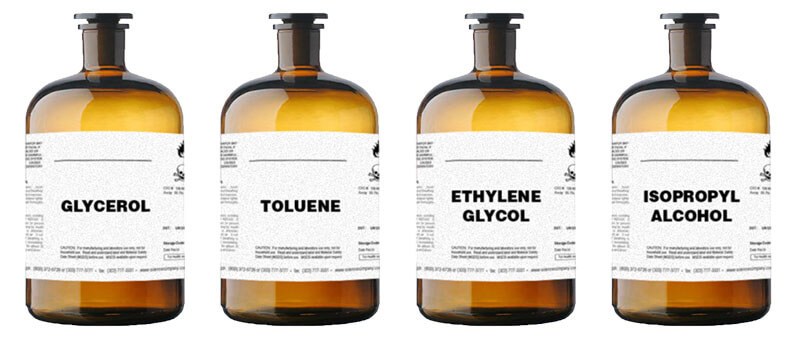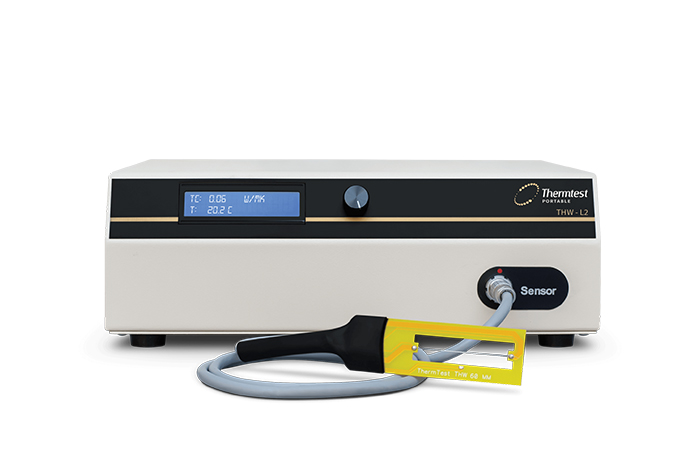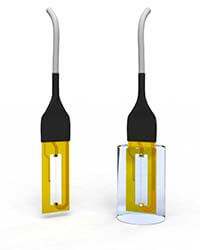Join us at the International Thermal Conductivity Conference (ITCC) and the International Thermal Expansion Symposium (ITES).
Geological
Nanomaterials
Pastes
Pastes
Polymers
Fluids are commonly used as heat transfer agents in technological and commercial applications. Therefore, it is important to know a fluid’s thermal conductivity, to determine if it will efficiently transfer heat. For example, the thermal conductivity of water is 0.6 W/mK, which is higher than most liquids. Scientists have extensively studied the thermal properties of water and other heat transfer fluids. However, the same cannot be said for many liquids that are not used as heat transfer agents. For this reason, researchers at Thermtest determined the thermal conductivities of four commonly used solvents that have similar physical properties: toluene, glycerol, isopropyl alcohol and ethylene glycol.

Figure 1. To demonstrate, four clear, colourless solvents tested with the THW-L2 in Thermtest laboratories.
Four common solvents were chosen to be measured with the Thermtest Liquid Thermal Conductivity Meter (THW-L2). Each of the tested liquids are clear and colourless, and are typically used in our everyday lives. For example, toluene is an ingredient in paints and fingernail polish. Glycerol is used in pharmaceuticals and cosmetics. Similarly, isopropyl alcohol is a main component of rubbing alcohol; a household item used to disinfect minor injuries. Finally, ethylene glycol, another solvent that was tested, is commonly used as antifreeze and coolants in vehicles. This application page will demonstrate the ability of the THW-L2 to accurately measure the thermal conductivities of various liquids.

Figure 2. The Thermtest THW-L2 Liquid Thermal Conductivity Meter
Thermtest’s Liquid Thermal Conductivity Meter (THW-L2) is based on the transient hot wire (THW) technique and follows the ASTM Standard D7896-14 for thermal conductivity measurements. The THW-L2 measures the thermal conductivity of liquids and pastes from 0.01 to 2 W/mK, and between the temperatures of -50 and +100°C. Additionally, THW devices use transient approaches, and short test times of one second to limit the effect of sample convection. A thin, minimally invasive wire acts as a sensor and heat source during measurements. Furthermore, this method ensures accurate results within 5%, and excellent reproducibility, typically better than 2%.
Researchers measured the thermal conductivities of toluene, glycerol, isopropyl alcohol, and ethylene glycol with the THW-L2 at ambient temperatures. They first calibrated the sensor using readily available DIUF (deionized ultra-filtered) water, which has well-characterized thermal properties over a range of temperatures. After this, the transient hot wire sensor was inserted into the DIUF water sample, and the measured thermal conductivity value was adjusted to match the expected result at 24°C.
Subsequently, researchers individually introduced each solvent into the THW-L2 sample holder, and inserted the THW into the cell. Upon returning to isothermal conditions, 10 tests were performed with a 5-minute wait time between measurements. Accordingly, each of the solvents were measured at 24°C. Resulting measurements were auto-calculated by the THW-L2 software to determine the mean thermal conductivity values.

Figure 3. The THW-L2 sensor, with a thin heating wire that doubles as the sensor and heat source.
Table 1 displays thermal conductivity results of the four solvents, produced by the THW-L2. As expected, glycerol had the highest thermal conductivity, and toluene exhibited the lowest thermal conductivity (Table 1).
| Table 1. The thermal conductivity (W/mK) of various common solvents, measured with the THW-L2 Liquid Conductivity Meter, at 24 °C in Thermtest laboratories. | |||
| Sample | Measured λ (W/m·K) | Expected λ (W/m·K) | Relative Difference (%) |
|---|---|---|---|
| Toluene | 0.130 | 0.129 | 1.1 |
| Glycerol | 0.292 | 0.292 | 0.03 |
| Isopropyl Alcohol | 0.137 | 0.135 | 1.2 |
| Ethylene Glycol | 0.261 | 0.258 | 1.1 |
Comparatively, the mean thermal conductivity results for the THW-L2 measurements agreed well with published literature, within the stated accuracy of 5%. As the manufacturer of the THW-L2 suggests, users can expect an accuracy of ±5% and reproducibility of ±2%. Conclusively, all experimental results fell comfortably within the specified ranges.
In short, the THW-L2 is a powerful tool that produces accurate and reliable measurements within a streamlined package. The THW-L2 is an ideal choice for laboratories conducting thermal conductivity measurements of pastes and liquids within the ranges of 0.01 to 2 W/mK.
The THW-L2 Transient Hot Wire Liquid Thermal Conductivity Meter is an advanced measurement system for direct determination of the thermal conductivity of liquids and pastes in accordance with ASTM D7896-14. Portable, economical, accurate, and easy to use. Get your results without the effects of convection.
References: